We harvest ginger because of its flavor, spice, and aroma that change dishes’ taste and benefit health. But since the rhizomes are grown under the ground, you might wonder when and how to harvest them. Read on to find out.
Ginger is generally planted in early spring and harvested in the fall. It generally takes 8-10 months for the plant to develop enough for a good harvest. However, this might change if you harvest them late or early. You can take the entire plant out or harvest a portion when harvesting.
Though ginger can be harvested at any time of maturity, it is best to harvest them after 8-10 months of harvesting. This article will take you through the harvesting processes and timings in detail.
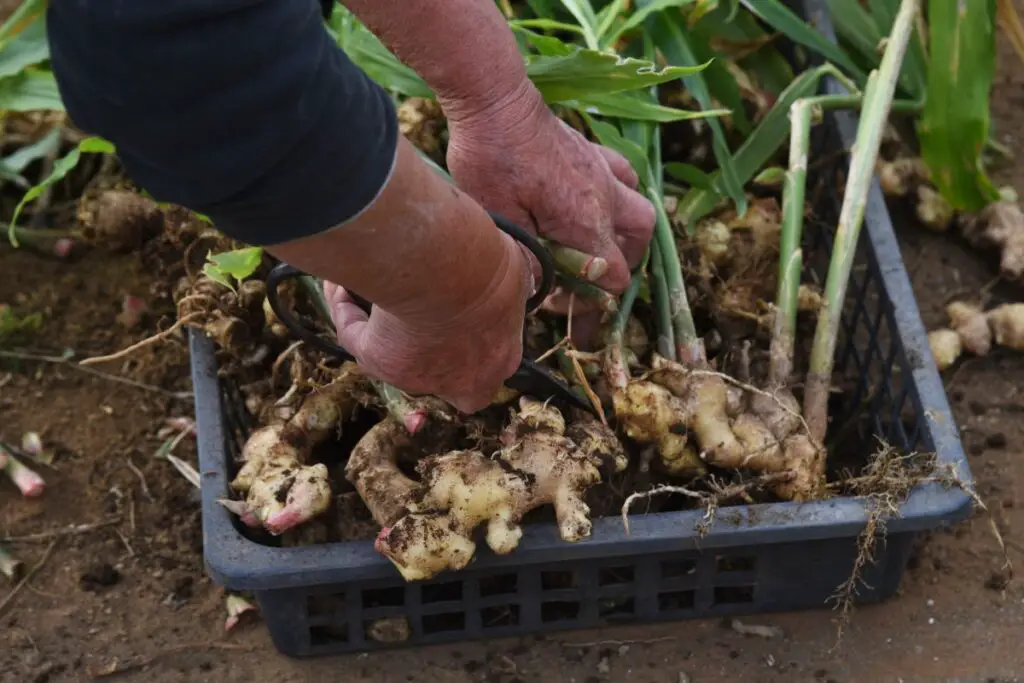
When does ginger get ready for harvest?
After planting, ginger can be harvested any time after four months.
It is the time when ginger starts entering the maturity stage.
So, after entering the stage, ginger can be harvested any time of the year.
In most areas, ginger is planted in the early spring or summer as that is when the weather warms up.
It gives the rhizomes enough heat and time to develop a strong root system.
After 4 months, the plant will get ready to be removed from the ground by the middle or end of the fall season.
After 2 months of planting, the rhizomes will begin to develop their root system.
After 4 months, they will start growing properly.
Also read:
- When To Plant Ginger Roots? (Ideal Season+Best Conditions)
- How Far Apart Should Ginger Be Planted? (+How Deep)
When is the best time to harvest ginger?
Though ginger can be harvested after 4 months, the best time is to harvest them 8-10 months after planting.
After 8-10 months, the ginger reaches an appropriate size and becomes healthy and juicy.
According to the season, if you have planted ginger in the early spring or summer, the best time is fall, before the frost risk arrives.
In these 8-10 months, the ginger rhizomes get enough heat, moisture, and nutrients to develop roots and have big and healthy rhizomes.
If you harvest ginger at 4-5 months, you will get very small ginger rhizomes. You can use them for culinary purposes or replant them.
How do you know when ginger is ready for harvest?
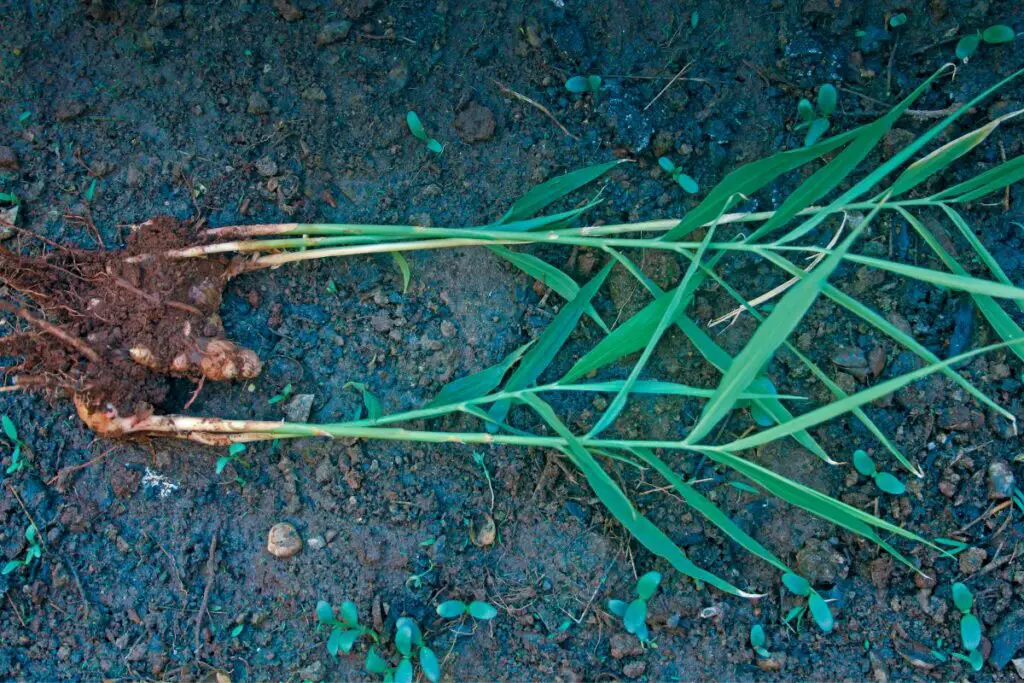
When your ginger is very well prepared for harvest, you will know the right time of harvest in the following ways:
The timing
You may plant ginger in the early spring, but they won’t be ready until the fall arrives.
Though you may harvest them a little earlier, the rhizomes will be small, and the root system won’t fully develop.
Ginger requires adequate time to grow and develop well with lots of warm weather.
Usually, ginger gets ready for harvest after 2-4 months.
But you will receive very small rhizomes.
The flowers and leaves
You can’t see what’s happening below the ground.
But you can guess it by some above-the-ground activities.
The flowers are a big sign that signifies that the ginger rhizomes are ready for harvest.
The ginger plants will have flowers, and you must wait for them to fade.
When the flowers fade and fall off, leaves will also turn yellow and fall off, and the stems will be yellow and dry out.
Once you see these signs, it indicates that the rhizomes are ready for harvest.
What happens if you harvest ginger late or early?
Determining the right time to harvest ginger is not a very confusing one.
Once they reach their maturity stage, you either harvest them early, or you can keep them a little more in the ground.
Looking for gardening supplies? We have tested 100's of products before recommending them to you guys. Check out our best pick below:
| Image | Gardening Supplies | Best Price? |
|---|---|---|
 Top
Top Top
Top | Raised Garden Bed Kit | Check On Amazon |
 | XLUX Soil Moisture Meter, Plant Water Monitor, Soil Hygrometer Sensor for Gardening, Farming, Indoor and Outdoor Plants, No Batteries Required | No Results |
 Top
Top Top
Top | 82 Pcs Garden Tools Set and Extra Succulent Tools Set | Check On Amazon |
 | Joeys Garden Expandable Garden Hose with 8 Function Hose Nozzle, Lightweight Anti-Kink Flexible Garden Hoses, Extra Strength Fabric with Double Latex Core, (50 FT, Black) | No Results |
 Top
Top Top
Top | Dual Chamber Compost Tumbler | Check On Amazon |
 Top
Top Top
Top | Sunnyglade Plant Stakes | Check On Amazon |
 Top
Top Top
Top | Organic Cold Pressed Neem Seed Oil | Check On Amazon |
 Top
Top Top
Top | Mighty Mint Gallon :-Insect and Pest Control Peppermint Oil | Check On Amazon |
 Top
Top Top
Top | Scotts DiseaseEx Lawn Fungicide | Check On Amazon |
 Top
Top Top
Top | Jacks Classic 20-20-20 All Purpose Fertilizer | Check On Amazon |
 Top
Top Top
Top | 30,000 Seeds Pollinator Attracting Wildflower Mixture | Check On Amazon |
 Top
Top Top
Top | Survival Vegetable Seeds Garden Kit-Over 16,000 Seeds | Check On Amazon |
What happens if you harvest ginger early?
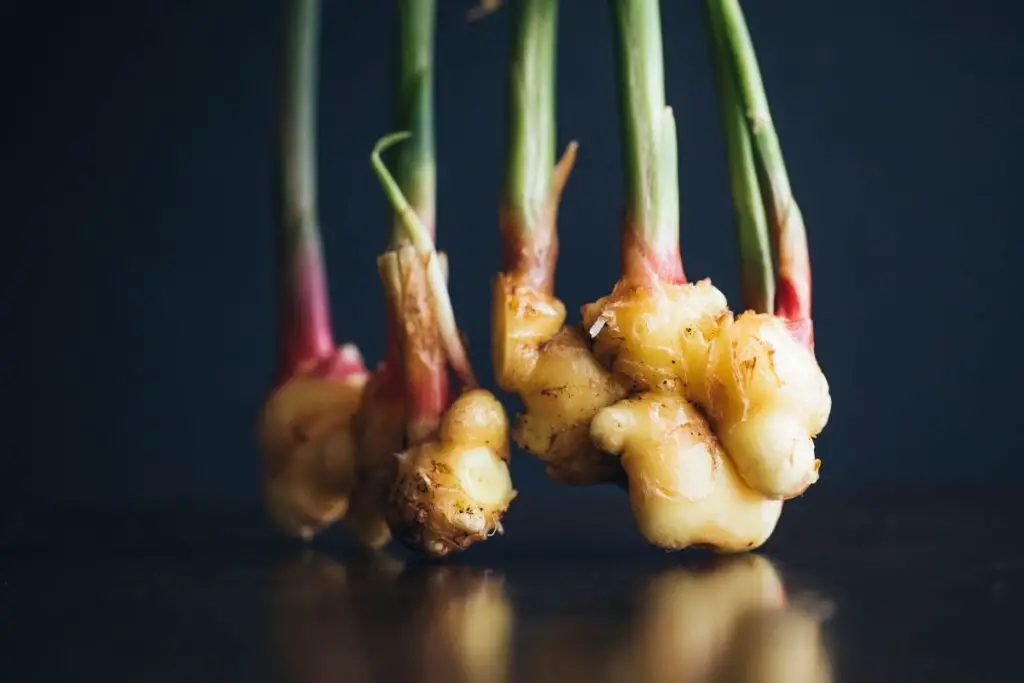
There is not any harm if you harvest the ginger rhizomes early.
Ginger can be harvested after 2-4 months of planting.
But, you will not get bigger rhizomes.
Besides, the roots won’t be strong enough.
If you harvest ginger early, you will receive young green ginger.
The taste might not be as good as the mature gingers.
What happens if I harvest ginger too late?
There is no problem if you harvest ginger a little late.
If you have this plan, then make sure you plant the rhizomes at a proper distance.
Under the ground, the rhizomes will keep growing bigger if you don’t harvest them.
So, they will need some space to enlarge.
You must also protect the plant from the winter season.
If you live in colder areas and plan to harvest ginger late, you should grow them in pots to bring them inside in the winter.
You can grow them in the ground if you are from hotter or moderate temperature areas.
During winter, protect them with a layer of mulch.
If there is any risk of frost, use a frost cloth.
What happens if I don’t harvest ginger?
If you don’t harvest the rhizomes, they will continue to grow under the ground, even during the winter.
So, you don’t have to worry about the right time for ginger harvest.
Just stop watering and protect them in winter. When spring arrives, you can start watering and caring for them again.
But, one drawback is the taste of the ginger will reduce when you harvest them at the next harvesting time.
The rhizome will be less flavored, and the texture will be fibrous.
You can try not harvesting in the current year once to check if you enjoy the test in the next year after harvesting.
If you like it, then you can follow the process. If not, harvest the rhizomes in the fall before the first frost.
How to harvest ginger?
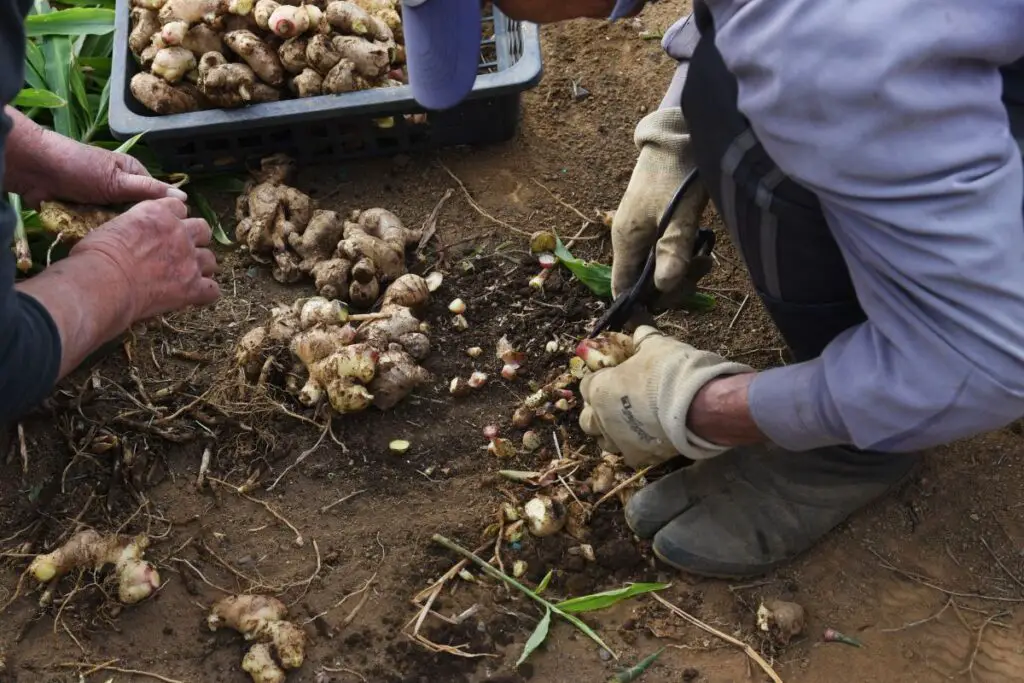
Once fall has arrived and the ginger flowers have faded and fallen off, it is time to harvest the ginger rhizomes.
The rhizomes are the main motive for growing ginger.
Preparing to harvest ginger
Start with a shovel, trowel, or spade, and create a circle around the area you want to dig up.
Ensure the distance between the circle and the stems is around 3-4 inches.
The circle’s purpose is to understand the rhizomes’ positions because they can be anywhere within this 3-4 inches circle.
Dig the area gently until the rhizome is visible.
Digging might require effort, and you must be slow and gentle to prevent hurting the rhizomes.
You don’t have to dig very deep because the depth will be only 2-4 inches.
Once you have found the rhizomes, you can collect them.
However, there are different situations for harvesting ginger rhizomes.
How to harvest green ginger?
After planting, ginger grows and becomes young enough to get harvested after 4 months.
You don’t wait for the plant to show any signs.
The young ginger is light cream with transparent skin.
Since they are young and not mature enough, they don’t have that smell and are not juicy like the bigger rhizomes.
If you want to get the gingers with that smell, aroma, and juiciness, you must wait 8-10 months to get them.
To receive a few young gingers, pick them after four months.
Remove the soil from around the plant using your hand or trowel, and cut off some ginger rhizomes from one side.
Again, cover the area with soil.
The rhizomes will again start growing from where you have cut them off.
Enjoy the fresh young ginger.
How to harvest mature ginger?
After you have taken preparation for harvest and loosened the soil around the ginger in a circular motion, the rhizomes will be visible to you.
Keep removing the soil until you can notice the root systems.
Use your hands to ease the job and remove the rhizomes from the plant base.
Gently bring the plant, and don’t be rough.
Otherwise, you will be hurting the rhizomes.
Once the plant has become loose enough to get pulled, hold the stems and pull them upward to dislodge them from the ground.
It might lead to the breaking off of some rhizomes.
But that’s fine because you will be separating them ultimately.
While using the gardening tools to take out the ginger, don’t be very rough or in a hurry, especially if you plan to harvest only the rhizomes.
Confused?
The next two points will clear your confusion.
Harvesting the whole plant and rhizomes
Ginger is mostly harvested by taking the whole plant out.
The reason for this could be:
- You get a lot of rhizomes at the right time because you need them.
- Your garden can get filled with many ginger plants, and you don’t need so much.
- You need space in your garden to plant new crops.
- You are unsure about growing ginger in the following year.
If you have any of the above reasons, you can harvest the rhizomes and the whole plant.
To harvest the whole plant, use your shovel and dig out the whole plant by pulling the stems from the ground.
It is fine if some of them get broken because, ultimately, they will get used.
Harvesting some parts of the rhizomes
The methods are somewhat like dividing the green ginger rhizomes.
Suppose you love growing ginger and have a permanent place for ginger in your garden.
In that case, you can harvest only some rhizome parts without taking the whole plant out.
The rule is to leave some rhizome parts and the plant in the ground and cut off some rhizomes per your need.
For this, find the rhizome and locate the end of the rhizome from where you want to divide it.
Avoid the part attached to the shoot.
Cut off some pieces, around 2-3 inches, and leave the rest in the ground.
Take care of them and protect them in winter.
Don’t feed or water the plants in winter.
When the temperature rises, start the care cycle by watering and fertilizing.
Harvesting aftercare
Once the harvest is complete, the rhizomes will require some post-harvest care to stay healthy and usable in the long run.
For that, follow the steps below:
- Begin with cutting the stems and washing the ginger. Since you brought the rhizomes from under the ground, they will have lots of mud. Try some lukewarm water to wash them thoroughly.
- Gently scrub the rhizomes with a clean brush to remove maximum dirt from every corner.
- Since ginger comes in awkward shapes, complete cleaning might be difficult. Let them dry and try after some time.
- Don’t throw away the stems of the ginger plants. You can use them for garnishing your dishes. But the taste remains for a very short time. So, when you use them, they may become unusable for your dish.
How do I store ginger after harvesting?
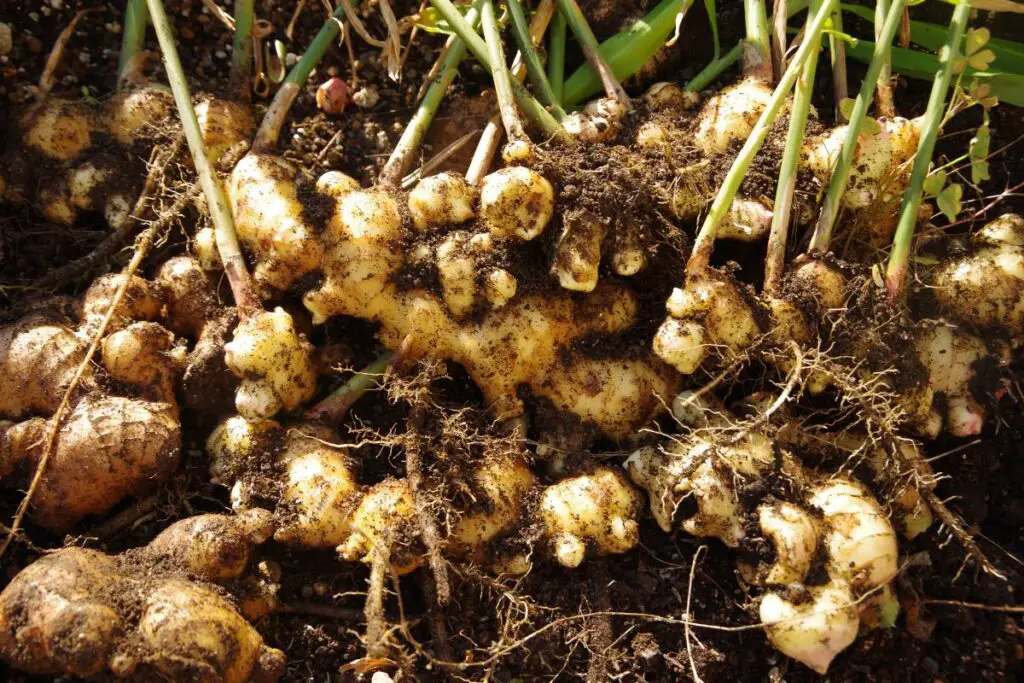
There are different but limited ways of storing the rhizomes:
Storing fresh ginger
You can peel off the rhizomes and store them in your refrigerator.
But make sure you use them before the water condensation rots them.
Fresh peeled ginger lasts for only 3-4 weeks.
Drying
Drying the rhizomes for storing can keep them last longer.
You can either keep them as a whole or process them into powder for storing.
The powdered one is used for baking and in tea.
Blending
Blending the rhizomes into a fine paste can be stored for a long time and used for culinary purposes.
You can either refrigerate them or freeze them to use them as needed.
Freezing
Freezing is a very good and usable method to store the rhizome.
The rhizomes won’t get easily damaged after peeling.
You can defrost them within a few minutes and use them.
You can freeze the ginger rhizomes for at least 2-3 months.
Can I eat ginger immediately after harvesting?
Once you harvest and clean the rhizomes properly, you can either store them or use them immediately for cooking or other purposes.
If you want to use these same rhizomes later in the next year, you have to store them well.
Don’t peel off the skin. Instead, cut the rhizomes into pieces, 1-2 inches each, and store them in an airtight container.
Place the container in the freezer for 4 months.
Whenever it is time, take them out and use them at your convenience.
Can I eat the ginger shoots?
We always want the rhizomes. But, you can also use the shoots for eating.
If you have harvested the whole plant, you can use the shoots.
Cut them into pieces like the spring onions and use them for garnishing.
They have a mild ginger smell.
Final thoughts
Harvesting ginger is very easy. If planted in spring, the best time to harvest ginger is in the fall, after 8-10 months when the ginger is fully matured.
You can also harvest them before, 4 months after planting, to receive young ginger. You can harvest ginger by taking the whole plant out or cutting off some rhizome parts and letting the remaining stay in the ground.
You can use the fresh ginger for cooking or store it in different ways to use later.
Reference: Ginger Production, Texas AgriLife Extension, USDA, Wikipedia
